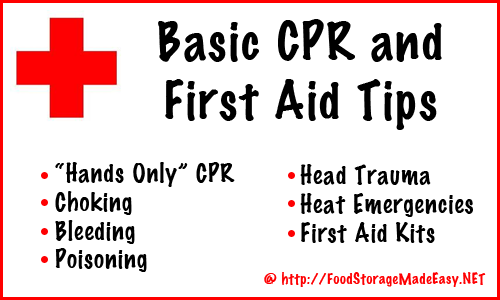I mentioned on our Facebook page last week that I had attended a first aid and CPR class at my local church. I learned a lot and wanted to share some of my notes of what I was taught with you here. I would strongly encourage you to take an official CPR class to get more formal instructions. Click here to search for one in your area.

“New” CPR Guidelines
This was not a formal CPR class but it was great to get a handle on the general principles. There have been some changes to what the American Heart Association recommends for people to know about performing CPR. Since 2008 they have been encouraging all Americans to learn Hands-Only CPR in order to be able to potentially save the life of someone in cardiac arrest. The American Heart Association website says:
Hands-Only CPR (CPR with just chest compressions) has been proven to be as effective as CPR with breaths in treating adult cardiac arrest victims. A study published in the March 8 issue of Circulation states: “Cardiovascular Quality and Outcomes showed that people who view a CPR instructional video are significantly more likely to attempt life-saving resuscitation.”
Official AHA Hands-Only® CPR instructional video.
A few extra notes from my class:
- For small children use one hand only and compress only about half the distance from your and to the ground
- For infants only use 2 fingers
- The first two compressions will be difficult and feel a bit “crunchy” as the ribs break away from cartilage, it should get easier after that.
- Don’t stop doing compressions until a doctor pronounces them dead, someone with higher training takes over, or you are so tired you are about to pass out
- Don’t check for a pulse or for breathing before you start, just start compressions immediately after calling 911. Precious time is lost otherwise.
What to do for CHOKING
Try to determine if it is a partial obstruction or a complete obstruction. If it’s partial, the object should be able to work it’s way out and the person is still able to breathe slightly. There is nothing you can do for this. If it is a complete obstruction, perform the heimlich maneuver. This is done by wrapping your arms around the person, place your thumb on their belly button, then make a fist and wrap your other hand around that fist. Pull up and back until the obstruction is removed. If the person goes unconscious, perform CPR.
What to do for severe BLEEDING
Call 911 if the cut is gushing, very deep, or a gaping wound. Do your best to stop or minimized the bleeding. If you are using a rag or towel to stop the bleeding, make sure to sterilize it first. You can attempt to stop the bleeding in one of three ways:
- Apply pressure, either directly (push right on the injury) or indirect (wrap a towel AROUND the injury)
- Use pressure points. Find any place you feel a heart beat near the wound and apply pressure (i.e. under the bicep)
- Elevate the injury
Once you have stopped the bleeding, do not remove the towel to check on the injury. Wait until medical help arrives or you get to a hospital.
What to do for POISONING
If you have ANY concerns about what a person (or pet) has eaten, call poison control immediately. The phone number is 1-800-222-1222
What to do for HEAD TRAUMA
If a person (usually a child) falls or receives some trauma to the head, check for the seriousness of the injury. If they are vomiting, go unconscious, act strange, get lethargic, or have a dramatic difference in pupil sizes these are all signs that it could be serious. If any of these symptoms occur, take the person to a doctor.
What to do for HEAT EMERGENCIES
Heat affects the young, old, and already sick much more than normal healthy adults. Heat exhaustion is quite common and is recognized by cool and clammy skin, nausea, and dizziness. Get the person out of the sun, keep cool, and have them drink lots of water. If heat exhaustion is not treated within 2-3 days, it can develop into heat stroke which is VERY dangerous. Signs of heat stroke are red skin, radiating heat, becoming incoherent or unconscious, and their body can’t control its temperature. This can be deadly, get medical attention IMMEDIATELY.
First Aid Kits
One last thing they mentioned in the class is to have a well-stocked first aid kit in your home. We gave a recommend list of first aid kit items from the Red Cross in this post last year. Check it out for a good starting point.
I still don’t feel like an EXPERT on all of these things, but I definitely feel a little more confident in managing first aid issues that may arise in my home with my little children. Hopefully you can find some classes in your area too!

-Jodi Weiss Schroeder
http://foodstoragemadeeasy.net

